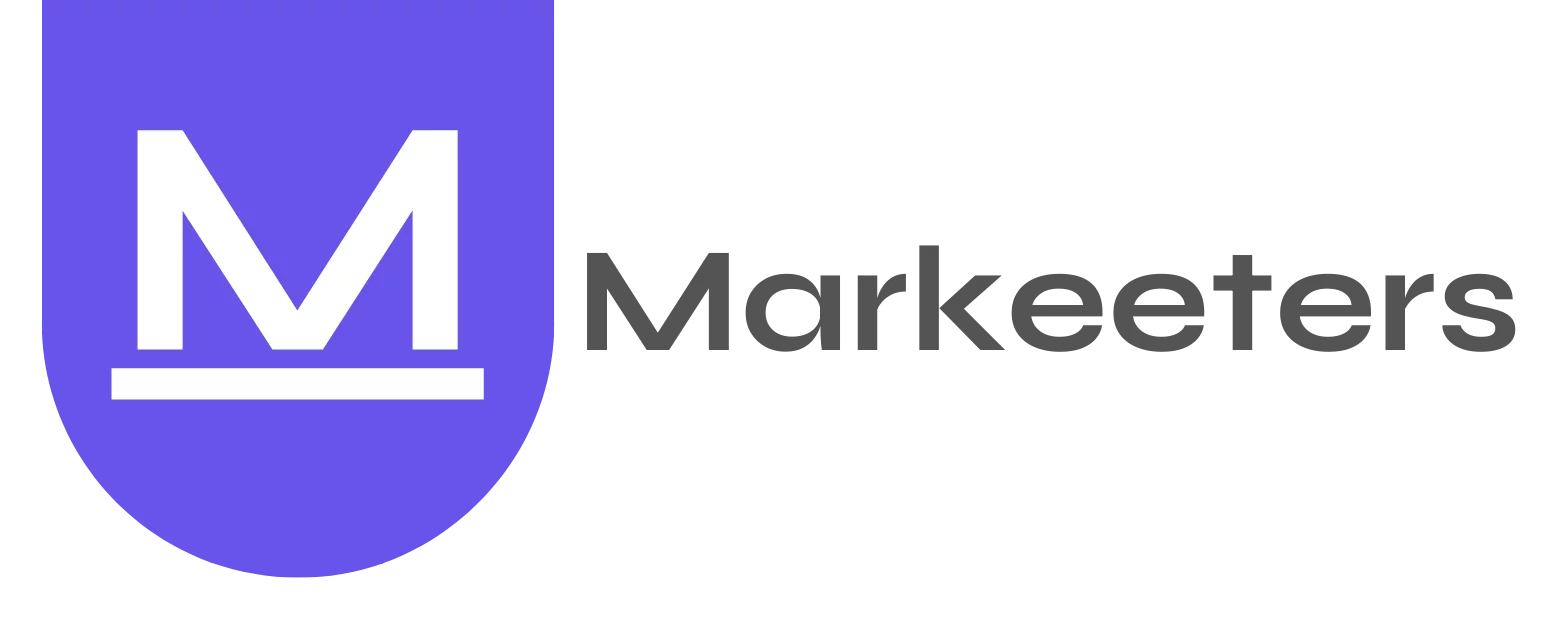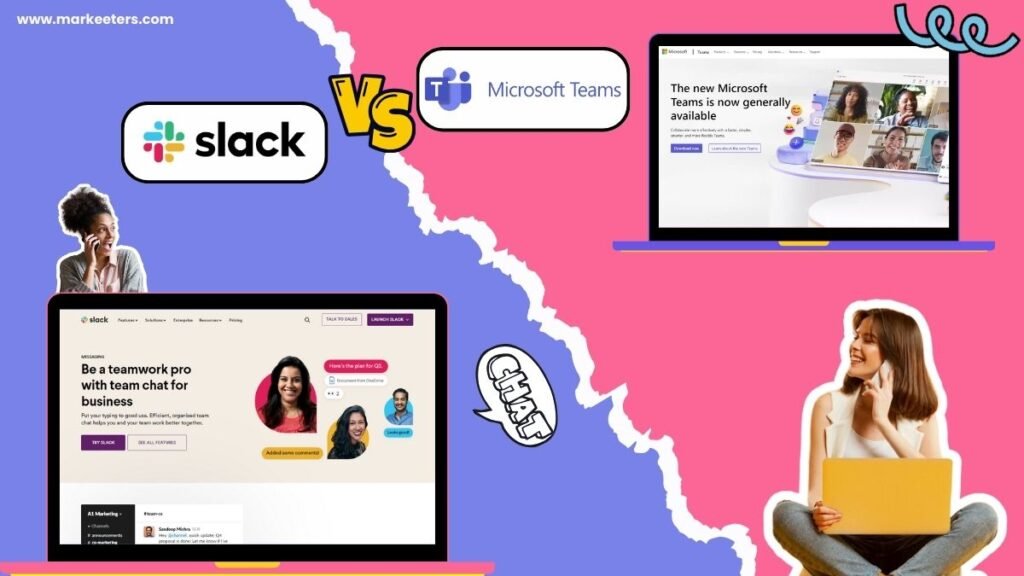Discover the latest in team communication: Slack vs Microsoft Teams – Team Communication Apps face-off 2024. Make an informed choice and improve efficiency. Explore now!
In 2019, the team collaboration software market surpassed $9.5 billion worldwide. In addition to this, chat and communication technologies are more essential because of the COVID-19 issue. This became a driving force for a significant movement towards remote employment. Companies are racing to put collaborative tools into place so they can maintain high levels of productivity during unpredictable times.
Collaboration software is a SaaS (software as a service) platform that facilitates real-time communication among employees as well as easy document sharing, task management, and automation of repetitive tasks. Also, collaboration software makes it possible to integrate additional third-party applications for increased efficiency, improved communication, and quicker task completion.
With today’s fast-paced growth and need for prompt answers, this software helps team members interact and solve problems more rapidly. Owing to its ease of use and scalability, this type of software is quickly gaining traction in a variety of businesses and sectors.
This blog will look at the most popular collaboration software, Slack and Microsoft Teams, to help you understand the right fit for your team.
What is Slack?
Slack is a communication and collaboration tool that can be used as a hub for any kind of organization. It has hundreds of connectors that make it simple to link applications you already use to its platform. It has features to help increase productivity and transparency across all teams (or, if required, silo information). It is simple to use and provides a free plan.
Slack is a productivity tool that provides companies with a central location for discussions, brainstorming, and teamwork. Its extensive number of connectors with other business programs that you probably already use adds even more capability to it. Slack facilitates communication in many ways, making it simple to hold a conference call, video conference, one-on-one chat, or group discussion.

In addition to this, Slack has a UI that is easy to grasp right away, making it instantly simple. Just establish channels based on projects or topics, then extend invitations to appropriate people to join those channels. Exchanging files is simple by using direct messaging or channels. And you can tweak everything, from emoticons to alerts.
Features
Documents
To share a file with others, just drag and drop it from your laptop into a direct message or channel. You can also incorporate a program like Google Workspace, which further simplifies file sharing and collaboration.
Communication
Slack’s most useful feature is conversation. Slack offers a variety of communication channels, but its core features are channel chat and direct messaging. Users on a free plan can check their history for up to 90 days before it starts to fade. Paid customers can view chats for as long as they like.
Whiteboard
This functions similarly to other whiteboards in that it allows you to brainstorm ideas with others. Together with others, you can develop material, exchange documents, photos, and videos, add checklists, and rearrange as necessary. Whiteboards, also known as Canvases can be used alone, in channels, and in direct messaging. Because they are shareable, you can email a Slack user a link to a canvas and let them update and participate, unless you lock edits.
Software Integrations
Slack is renowned for its ability to integrate with other kinds of software, expanding its range of features. More than 2,600 applications, including those in project management analytics, marketing, HR, and communication, integrate with Slack. Thus, you have the option to use Zoom for video conferences if that’s how you choose to do it and to quickly create documents using Dropbox or Google, for example.
Pros and Cons
| Pros | Cons |
|---|---|
| – Free plan is available – Easy-to-use interface – Advanced search function – 2500+ integrations – Automated work-flows on all paid plans – Various in-built communication options | – Costly plans – Limited users in huddles – Message history gets deleted |
Learn more with Markeeters:
What is Microsoft Teams?
Microsoft Teams is a member of the Microsoft suite 365 product. It is a platform for corporate collaboration. It can be represented as:
- A platform for business communication
- A platform for cooperation based on chat
- A cooperative work environment
- Cloud-based team collaborative software
Teams can be accessed by the Teams app, Teams mobile app, or a web browser.
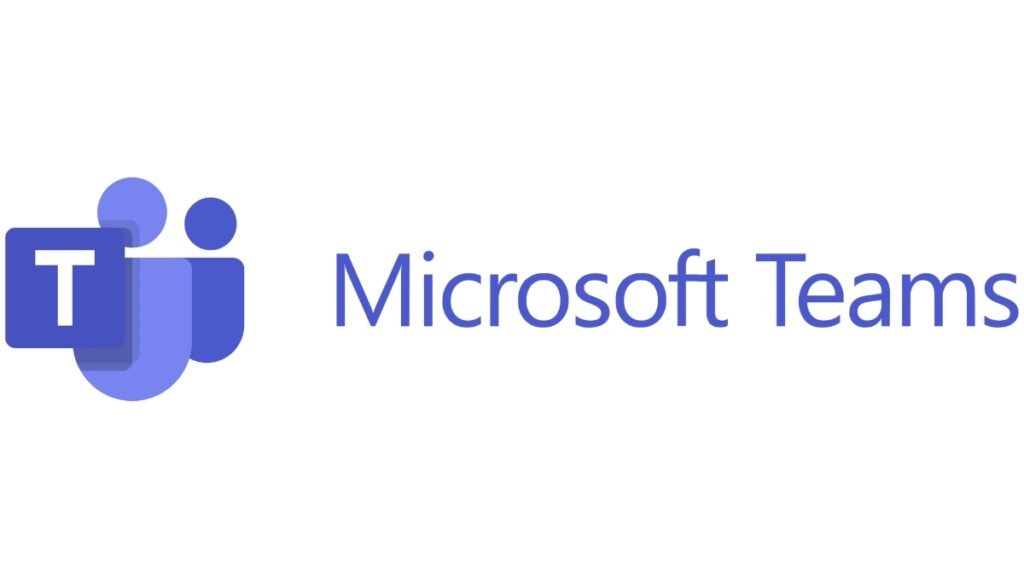
Features
Channels
Users can establish channels within Teams. Conversation themes are channels. For instance, the marketing team can use social media, advertising, content, and so on as channels. This will make file sharing and team conversations inside Teams more searchable and structured.
Chat
Chat is the most used and popular feature of Teams. When used properly, it can drastically reduce the number of emails exchanged by your team members. Chats are persistent, and team members can swipe up to catch up on missed content or search the conversation to discover a certain topic. Using the @ key, users can mention other team members, which will send a notification to appear on their laptop or mobile app.
Teams
Users can form teams and ask others to join. Teams are often organized around a particular function, like finance or marketing. But you can also extend your invitation to anyone from outside your company to join.
Integrations
Microsoft Teams is a one-stop workplace. It allows you to add hundreds of other apps as tabs. Project management applications, polling apps, and motivation and recognition apps are examples of common integrations.
Team Meetings
Videoconferencing is the second-most-used feature in Teams. This tool includes audio and video calls, sidebar chat, screen sharing, meeting recording, file sharing, and more.
Pros and Cons
| Pros | Cons |
|---|---|
| – Easy implementation – Increased team productivity – Improved work performance | – Limited flexibility – Different online meeting experience – Confusing file structuring |
Read more:
- Google Meet vs Zoom vs Microsoft Teams – Comparing Top Video Conferencing Tools (2024)
- Hootsuite vs Sprout Social: Social Media Management Tool Comparison
Slack vs Microsoft Teams: A Quick Review
| Feature | Slack | Microsoft Teams |
|---|---|---|
| Messaging and Chat | – Conversations organized in channels – Direct messages – Threads for focused discussions | – Conversations organized in channels – Direct messages – Threads for focused discussions |
| Integration | – Extensive third-party app integration – Custom app integrations using APIs – App directory for easy discovery | – Integration with Microsoft 365 apps – Integration with Power Platform – Third-party app integrations |
| File Sharing | – File sharing with version control – Real-time collaboration on documents | – Integration with OneDrive and SharePoint – Co-authoring in real-time |
| Video Conferencing | – Integration with third-party video tools – Screen sharing and audio calls | – Built-in video conferencing – Meetings with scheduling options |
| Audio and Video Calls | – Audio and video calls – Screen sharing during calls | – Audio and video calls – Meeting recordings |
| Collaboration Tools | – Shared channels for cross-organization – Emoji reactions and mentions | – Microsoft Planner for task management – Wiki for documentation |
| Search Functionality | – Powerful search across channels in DMs – File search with preview | – Intelligent search with filters – Integration with Microsoft search |
| Security and Compliance | – Enterprise-grade security features – Data encryption in transit and at rest | – Compliance with Microsoft 365 standards – Multi-factor authentication |
| User Interface | – Simple and intuitive interface – Customizable themes and emojis | – Familiar Microsoft 365 design – Tabs for easy access to tools |
| Cost | – Pricing based on active users – Free as well as paid plans | – Included in Microsoft 365 subscription – Additional costs for advanced features |
Slack vs Microsoft Teams: A Detailed Comparison
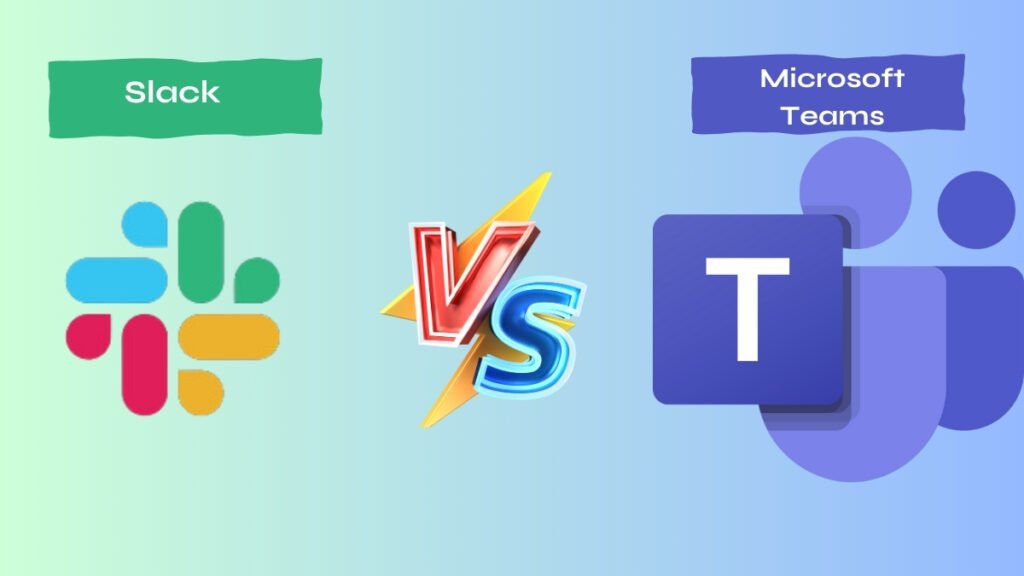
Slack vs Microsoft Teams: Collaboration Features
| Slack | Microsoft Teams |
|---|---|
| – There are several good collaboration features in Slack. For instance, to talk about the project specifications, you can join 15 team members via an audio or video conference called a “Huddle.” Slack lacks an integrated calendar, but you can schedule work using the Google Calendar app. – You must install third-party software, such as Miro, on Slack if you want to work on designs, programs, or documents in real-time. Therefore, Slack takes you to the collaboration app when you need to access a shared design or coding interface with others. | – Microsoft Teams is a powerful collaboration tool. You can connect up to 250 team members for lengthy video conferences, screen sharing, and content sharing. Teams allow you and your team to open Microsoft 365 applications like Word, Excel, or Power Point in real-time on the same project. |
Slack vs Microsoft Teams: User Interface (UI) & User Experience (UX)
| Slack | Microsoft Teams |
|---|---|
| – Slack has an easy-to-use interface. All of the current Slack workspaces are displayed in the far-left side panel. Workspaces might be organizations, groups, a wide range of projects, etc. – Channels and Direct Messages are among the areas located beneath the parent workspace. You can visit Browse Slack to get a panoramic picture of the whole Slack platform. Using Slack, hopping between multiple workspaces is really simple. To switch, simply click the Workspace symbol on the left. | – Microsoft Teams has an advanced user interface. Chat, Shift, Teams, Activities, Apps, etc. are the main parts. This panel can be customized if necessary. To send direct messages, navigate to the chat area. – The Teams portion is most helpful. You can establish distinct teams for various departments and securely interact with them. Team groups function similar to Slack channels. But Teams may contain a lot of items like Posts, Files, Documents, SharePoint, etc. – Switching between accounts and enterprises can be challenging. On the same device, you will encounter the two-factor authentication frequently. It also takes time for the material to load if you add another account or join another person’s team. |
Slack vs Microsoft Teams: Communication and Collaboration
| Slack | Microsoft Teams |
|---|---|
| – Slack is useful for messaging in a threaded view. Additionally, you can open individual chats as Threads on the app’s right side and leave comments on them. But alerts for direct messages and threads are not the same. Slack is not practical for holding extensive voice, video, and screen-sharing team meetings. | – Microsoft Teams uses a communication interface. Reactions and remarks to specific conversations, however, appear in the same thread as those on Messenger and WhatsApp. Additionally, if you and your team log in to Teams using the company email, you can simply access files and documents that are saved in OneDrive or SharePoint. |
Slack vs Microsoft Teams: Integration
| Slack | Microsoft Teams |
|---|---|
| – Slack connects your workspace with external business apps through apps. All of these apps are available in the Slack App Directory. – As of now, there are around 2,600 applications. A variety of areas are available for selection, including analytics, communication, design, file management, and productivity. | – Microsoft Teams supports up to 2,000 integrations. Asana, Trello, Mural, Monday.com, Fireflies.ai, Salesforce, ClickUp, Jira, and more platforms are integrated. |
Slack vs Microsoft Teams: Pricing
Slack

Microsoft Teams
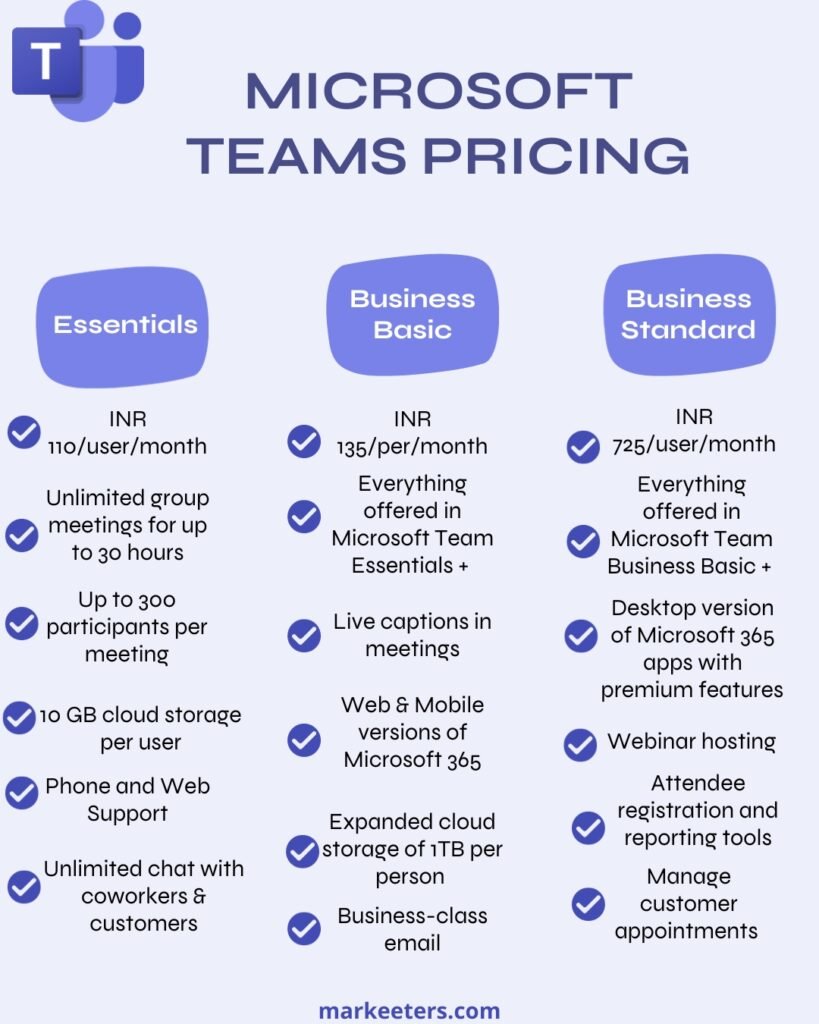
Slack vs Microsoft Teams: Conclusion
Slack is an excellent option if video calling is not a big part of your business. Additionally, if you have made significant investments in Salesforce and Google Workspace, you will find Slack offers great ease and efficiency.
On the other hand, Teams is an ideal choice if your business has been set up using a variety of Microsoft applications, including Word, Excel, PowerPoint, PowerApps, SharePoint, and so forth. Additionally, Teams provide the style and appearance you desire if your company is more corporate.
Additional resources for you:
- The Ultimate Guide to Social Media Marketing for Small Businesses
- SEO Strategy for Real Estate Agency
- SEO Strategy for Financial Advisors
FAQs
Is MS Teams better than Slack?
Teams is a full-featured collaboration suite that includes chat, video conferencing, and integrated document management, Slack is a chat-based collaboration solution that prioritizes communication.
Why choose Slack over Teams?
Both tools provide excellent opportunities for collaboration. In terms of usability, convenience, and integrations, Slack wins. Teams wins when it comes to connections with Office Suite 365, search functionality, and video conferencing.
